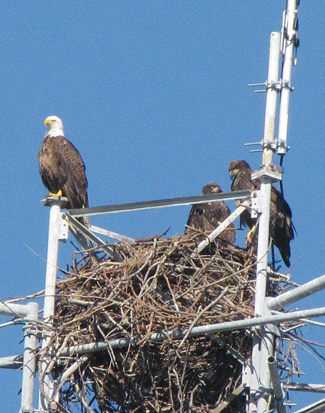Focus on Nature: Heading home, as Florida spring blooms

Barbara is in the kitchen finishing up the dinner dishes while I try to get started on my last article written down here in Florida. The winter has gone by quickly with lots of challenges in the world around us. Looking back, it was one of the coldest winters we’ve seen in the six years we’ve spent here. And yet in the past few weeks spring finally arrived with perfect weather, the exception being the one-hour storm that came upon us recently, with its many tornadoes leaving lots of damage to the north of us.
It was one of the closest things to a hurricane I’ve seen, with wind gusts up to 70 mph along with torrential rains of up to four or five inches. There was a big celebration near us with small planes from all over the country participating. At least 40 of the planes flipped over or were damaged, streets were flooded, mobile homes and tractor trailers were blown over and trees were downed everywhere; some 78,000 homes were without electricity.
Yet soon the weather bounced back and we were able to get out and check on an eagle’s nest that friends told us about. The nest is about 150 feet in the air on one of those high communication towers. It is a huge cone-shaped nest; eagles make the largest nest of any bird in North America.
One can see why the eagle was chosen as the national bird. My, but they are regal-looking. They have an evenly brown body with a white head and tail; male and female are identical in color, the female being the larger of the two. They are big birds with a body length of 28 to 38 inches and a wingspan of 66 to 88 inches, and weighing from 6 to 13 pounds. The two young looked almost as large as their parents and were easily identified by their dark brown coloring. What a beautiful sight, watching the adult birds as they flew into the nest with food for the young — something we don’t get to see back home.
The bald eagle was affected by the use of DDT, as our ospreys were, and the population was once reduced to some 400 nesting pairs in the United States. By the 1950s, regulations and environmental education advanced the eagle’s recovery to where it now has a stable population and has been officially removed from the list of endangered species.
Bald eagles mate for life; as with osprey, should one die or get killed, sooner or later the surviving one will choose another mate. The life expectancy of these handsome birds can sometimes reach 30 years.
They select a nesting site close to a large body of water that contains fish, their predominate food. These birds of prey hunt and fish by swooping down and snatching the fish out of the water with their talons. The bald eagles we see in Florida are resident birds, so they hunt and fish year ’round.
Years ago, when there was a movement to establish the bald eagle as the national symbol, Benjamin Franklin suggested that instead the wild turkey be chosen as the symbol of American qualities. He described the bald eagle as a bird of bad moral character that was too lazy to fish for itself but survived by robbing the osprey of its catch.
I can verify this, as I once watched an eagle out in Orient chase an osprey flying back to its nest with a fresh catch. Once the eagle caught up with the osprey, the osprey let go of the fish and the eagle quickly snatched it out of the air. What a sight!
Of course, Florida’s spring awakened weeks ago, with blossoms of all kinds of colors showing in flowers, shrubs and trees; yes, many of the trees or tall shrubs have colorful blossoms. It’s a fairyland of awakening.
By the time this article appears, snowdrops and the rugged early blossoms of the crocus will be long past on the North Fork. What we really look forward to seeing are our latest daffodils that were put in before we left for Florida. Our previous planting, which was down our driveway, became a disaster. For some reason a squirrel or raccoon went along and dug up all the newly planted bulbs and left them to rot. Was this some sort of game they were playing? We love daffodils and with the wide variety of colors and shapes that are offered today they are always something to look forward to.
Florida is a great place to be, especially this year when you up north had your share of cold temperatures, ice, snow and dreary weather. It’s time again to head north and anticipate seeing the spring flowers and shrubs and trees as they burst forth for another year.
P.S. As we write this, the first hummingbird of the season, on its migration north, stopped by from its winter in the Caribbean to check out our petunias. What a jewel.


